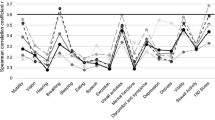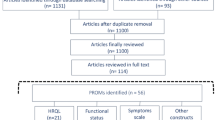Abstract
Collection of patient-centred health status is a method for quantifying patient outcome in the context of clinical trials for the treatment of coronary artery disease (CAD). Traditional clinical trial end-points, such as morbidity and mortality, fail to adequately measure the health-related outcomes of disease states for which death is a rare occurrence. Health-related quality of life (QOL) and functional status surveys allow measurement of the general, and/or disease-specific, health-related limitations experienced by patients. Measures of patient preference, in turn, quantify the effects these health-related limitations have on the overall value patients ascribe to their current health state.
Together, these outcomes measures may provide a more accurate appraisal of the benefit conferred by treatment. Currently, selection of the appropriate outcomes measures and methodological approaches for a clinical trial is complicated by the lack of consensus on a single quality of life measure for use with patients with (CAD). This article outlines the use of QOL measures in anti-anginal trials done to date and summarises the approaches currently available for assessing QOL, including the differences between psychometric and preference-based techniques, and general and disease-specific health measures. In conclusion, a framework is provided for selecting the appropriate instruments and methodology in the context of the clinical trial.
Similar content being viewed by others
References
Fries JF, Singh G. The hierarchy of patient outcomes. In: Spilker B, editor. Quality of life and pharamcoeconomics in clinical trials. 2nd ed. Philadelphia (PA): Lipincott-Raven, 1996: 33–40
Patrick DL, Deyo RA. Generic and disease-specific measures in assessing health status and quality of life. Med Care 1989; 27: S217–32
Tsevat J, Weeks JC, Guadagnoli E, et al. Using health-related quality-of-life information: clinical encounters, clinical trials, and health policy. J Gen Intern Med 1994; 9(10): 576–82
Spertus JA, Winder JA, Dewhurst TA, et al. Monitoring the quality of life in patients with coronary artery disease. Am J Cardiol 1994; 74: 1240–4
Rogers WJ, Coggin CJ, Gersh BJ, et al. Ten-year follow-up of quality of life in patients randomized to receive medical therapy or coronary artery bypass graft surgery (CASS). Circulation 1990; 82(5): 1647–58
Nissinen A, Wiklund I, Lahti T, et al. Anti-anginal therapy and quality of life: a comparison of the effects of transdermal nitroglycerin and long acting oral nitrates. J Clin Epidemiol 1991; 44(9): 989–97
Dupuy HJ. The psychological well-being (PGWB) index. In: Wenger N, Mattson M, Furberg C, et al., editors. Assessment of quality of life in clinical trials of cardiovascular therapies. New York: Le Jacq, 1984: 170–83
Wilson A, Wiklund I, Lahti T, et al. A summary index for the assessment of quality of life in angina pectoris. J Clin Epidemiol 1991; 44: 981–8
Fletcher A, McLoone P, Bulpitt C. Quality of life on angina therapy: a randomised controlled trial of transdermal glyceryl trinitrate against placebo. Lancet 1988; II: 4–8
Ronnevik PK, Silke B, Ostergaard O. Felodipine in addition to beta-adrenergic blockade for angina pectoris. Eur Heart J 1995; 16: 1535–41
Hinkle LE, Witney LH, Lehman EW, et al. Occupation, education and coronary heart disease. Science 1968; 161: 238–46
Rehnqvist N, Hjemdahl P, Billing E, et al. Effects of metoprolol vs verapamil in patients with stable angina pectoris. Eur Heart J 1996; 17: 76–81
Kaplan RM, Anderson JP, Wu AW, et al. The quality of well-being scale: applications in AIDS, cystic fibrosis, and arthritis. Med Care 1989; 27: S27–43
Bergner M, Bobbitt RA, Carter WB, et al. The sickness impact profile: development and final revision of a health status measure. Med Care 1981; 19: 787–805
Read JL, Quinn RJ, Hoefer MA. Measuring overall health: an evaluation of three important approaches. J Chronic Dis 1987; 40(1 Suppl.): S7–21
Deyo RA, Inui TS, Leininger JD, et al. Measuring functional outcomes in chronic disease: a comparison of traditional scales and a self-administered health status questionnaire in patients with rheumatoid arthritis. Med Care 1983; 21: 180–92
DeBruin AF, De Witte LP, Stevens F, et al. Sickness impact profile: the state of the art of a generic functional status measure. Soc Sci Med 1992; 35: 1003–14
Beaton DE, Bomardier C, Hogg-Johnson S. Choose your tool: a comparison of the psychometric properties of five generic health status instruments in workers with soft tissue injuries. Qual Life Res 1994; 3: 50–6
Liang MH, Fossel AH, Larson MG. Comparisons of five health status instruments for orthopedic evaluation. Med Care 1990; 28: 632–42
Hays RD, Sherbourne CD, Mazel RM. The RAND 36-item health survey 1.0. Econ Eval 1993; 2: 217–27
Ware JE, Sherbourne CD. The MOS36-item short-form health survey (SF-36): conceptual framework and item selection. Med Care 1992; 30: 473–83
Rand Health Sciences Program. RAND 36-item health survey 1.0. Santa Monica (CA): Rand Corporation, 1992
Katz JN, Larson MG, Phillips CB, et al. Comparative measurement sensitivity of short and longer health status instruments. Med Care 1992; 30: 917–25
Medical Outcomes Trust. How to score the SF-36 short-form health survey. Boston (MA): The Medical Outcomes Trust, 1992
Ware JE, Snow KK, Kosinski M, et al. SF-36 health survey: manual and interpretation guide. Boston (MA): The Health Institute, New England Medical Center, 1993
Hlatky MA. Patient preferences and clinical guidelines. JAMA 1995; 273(15): 1185–90
Nease RF, Kneeland T, O’Conner GT, et al. Variation in patient utilities for outcomes of the management of chronic stable angina. JAMA 1995; 273(15): 1185–90
von Neumann J, Morgenstern O. Theory of games and economic behavior. Princeton (NJ): Princeton University Press, 1947
Weinstein MC, Fineberg HV. Clinical decision analysis. Philadelphia: WB Saunders, 1980
Torrance GW, Feeny DH, Furlong WJ, et al. Multiattribute utility function for a comprehensive health status classification system: Health Utilities Index Mark 2. Med Care 1996; 34(7): 702–22
Keeny RL, Raiffa H. Decisions with multiple objectives: preferences and value tradeoffs. New York (NY): John Wiley, 1976
Gold MR, Siegel JE, Russell LB, editors. Cost-effectiveness in health and medicine. New York (NY): Oxford University Press, 1996
Martin AJ, Lumley TS, Simes RJ. Incorporating trade-offs in quality of life assessment. In: Spilker B, editor. Quality of life and pharmacoeconomics in clinical trials. Philadelphia: Lippincott-Raven, 1996: 403–12
EuroQol Group. EuroQol: a new facility for the measurement of health-related quality of life. Health Policy 1990; 16: 199–208
Kaplan RM, Anderson JP, Ganiats TG. The quality of well-being scale: rationale for a single quality of life index. In: Walker SR, editor. Quality of life assessment: key issues in the 1990’s. Dordrecht, Netherlands: Kluwer Academic Publishers, 1993: 65–94
Kaplan RM, Bush JW, Berry CC. Health status: types of validity and the Index of Weil-Being. Health Serv Res 1976; 11: 478–507
Feeny DH, Torrance GW, Furlong WJ. Health utilities index. In: Spilker B, editor. Quality of life and pharmacoeconomics in clinical trials. Philadelphia (PA): Lippincott-Raven, 1996: 239–52
Feeny DH. Multi-attribute health status classification systems. Pharmacoeconomics 1995; 7: 490–502
Patrick DL, Erickson P. Health status and health policy: allocating resources to healthcare. New York: Oxford University Press, 1993
Cohen DJ, Breall JA, Ho KK, et al. Evaluating the potential cost-effectiveness of stenting as a treatment for symptomatic single-vessel coronary disease: use of a decision-analytic model. Circulation 1994; 89(4): 1859–74
Patrick DL, Deyo RA. Generic and disease-specific measures in assessing health status and quality of life. Med Care 1989; 27(3 Suppl.): S217–32
Guyatt GH, Jaeschke R, Feeny DH, et al. Measurements in clinical trials: choosing the right approach. In: Spilker B, editor. Quality of life and pharamcoeconomics in clinical trials. Philadelphia: Lipincott-Raven, 1996; 41–48
Cleary P. Health-related quality of life in persons with AIDS. Med Care 1993; 31(7): 569–80
Cox J, Naylor CD. The Canadian Cardiovascular Society grading scale for angina pectoris: is it time for refinements? Ann Intern Med 1992; 117: 677–83
Goldman L, Hashimoto B, Cook EF, et al. Comparative reproducibility and validity of systems for assessing cardiovascular functional class: advantages of a new specific activity scale. Circulation 1981; 64(6): 1227–34
Hlatky MA, Boineau RE, Higginbotham MB, et al. A brief self-administered questionnaire to determine functional capacity (The Duke Activity Status Index). Am J Cardiol 1989; 64: 651–4
Nelson CL, Herndon JE, Mark DB, et al. Relation of clinical and angiographic factors to functional capacity as measured by the Duke Activity Status Index. Circulation 1991; 68(9): 973–5
Spertus JA, Winder JA, Dewhurst TA, et al. Development and evaluation of the Seattle Angina Questionnaire: a new functional status measure for coronary artery disease. J Am Coll Cardiol 1995; 25(2): 333–41
Guyatt GH, Walter S, Norman G. Measuring change over time: assessing the usefulness of evaluative instruments. J Chronic Dis 1987; 40: 171–8
Author information
Authors and Affiliations
Corresponding author
Rights and permissions
About this article
Cite this article
Bliven, B.D., Green, C.P. & Spertus, J.A. Review of Available Instruments and Methods for Assessing Quality of Life in Anti-Anginal Trials. Drugs & Aging 13, 311–320 (1998). https://doi.org/10.2165/00002512-199813040-00007
Published:
Issue Date:
DOI: https://doi.org/10.2165/00002512-199813040-00007




